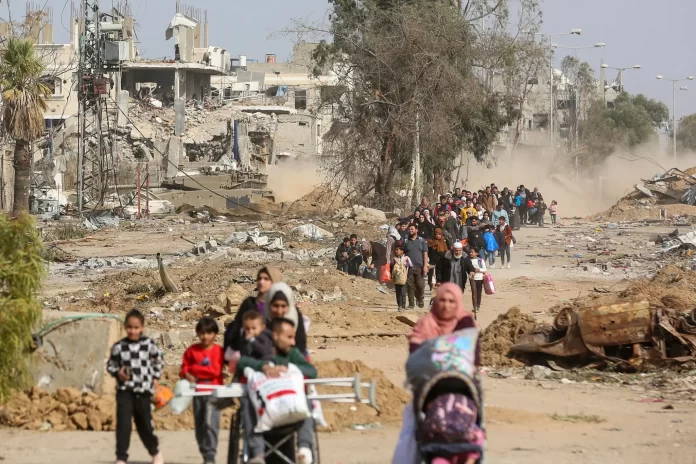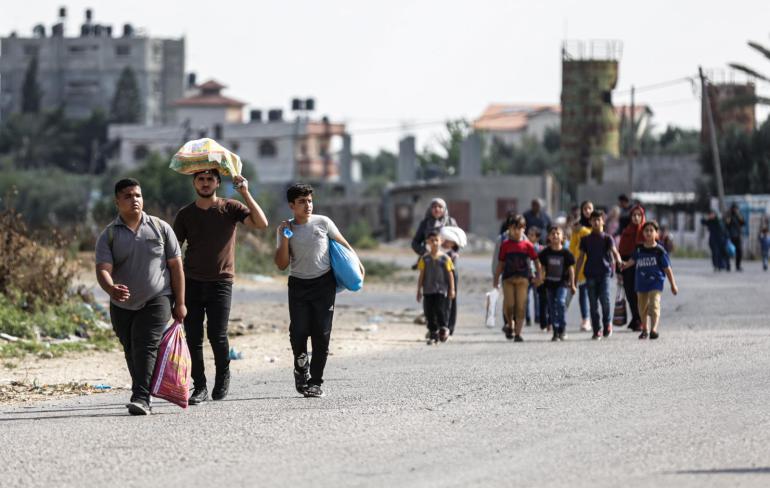The Gazan walked for hours, raising their hands when they encountered Israeli troops with guns trained on them to display their ID cards — or wave white rags. All around them was the sound of gunfire and the incessant buzzing of drones. Bodies littered rubble-filled streets.
For the tens of thousands of Gazans who have fled the northern part of the enclave where the heaviest fighting has been taking place, evacuating to the south has been a perilous journey, according to at least 10 Gazans that The New York Times spoke to on the ground and by phone.
Even though a tenuous cease-fire in place since Friday has brought temporary relief from the bombardment, they face an uncertain future — and the threat that the strikes will return, leaving them displaced yet again.
For weeks, Israel has been urging Gazans living in northern towns to flee along Salah al-Din Street, the strip’s main north-south highway.
Those lucky enough or with means fled early, but some Gazans who spoke to The Times said they could not leave earlier because they do not have relatives or anyone they know in the south, cannot leave older family members behind or don’t have the resources. Instead, many sheltered in increasingly dangerous and desperate conditions at schools or hospitals in the north. But at some point, they made the difficult decision to leave.
Even that decision was fraught. In the weeks leading up to the cease-fire, Israel has also bombed the southern part of the Gaza Strip, and some Gazans feel uprooting themselves further with no guarantee of shelter in the south is not worth it.
The United Nations says 1.7 million of the 2.3 million residents in the Hamas-controlled enclave have been displaced.
The Gazans who spoke to The Times said they felt shame, loss of dignity and anger at finding themselves struggling for their lives in the latest war between Israel and Hamas. The journey — which takes Gazans hours depending on where in the north they are leaving from — is usually done on foot or on a donkey cart.
Aya Habboub, 23, remained in northern Gaza earlier this month, heavily pregnant with her third child. She gave birth in a hospital under intense bombardment but was forced to evacuate when the baby, whom she named Tia, was just four days old.
Barely able to walk, Ms. Habboub tried to rest by the side of the road, but her husband urged her to keep going. Israeli soldiers, she said, stopped her mother-in-law and ordered the woman to stand for half an hour and raise her hands.
“Then they were firing,” Ms. Habboub said, “and we started running.” Ms. Habboub was speaking in a hospital in Deir al-Balah, a city in central Gaza, where many are sheltering. In her lap, Tia, cocooned in a white cloth, was sleeping peacefully.
“I dropped my baby,” she said. “I was crying and screaming.”
Several Gazans whom The Times spoke to described similar scenes of soldiers firing in the general vicinity of those fleeing. It was not possible to verify independently such claims.
The Israel Defense Forces did not comment on the specific allegations. In a statement responding to questions about them, the military said it had taken “significant precautions to mitigate civilian harm.” It added that it had issued warnings of airstrikes ahead of time, when it can do so, and told civilians when to make use of “safe corridors” to evacuate.
It reiterated its assertion that Hamas has embedded itself within “civilian infrastructure” and uses civilians as human shields. “The I.D.F. is determined to end these attacks, and as such we will strike Hamas wherever necessary,” it said.
In the few days since a temporary truce between Israel and Hamas took hold, some Gazans have continued moving south. Others have tried to return north to check on loved ones and their homes, but Israeli troops have prevented that.
Mohammed El-Sabti said he began a trek from the Zeitoun neighborhood in Gaza City on a recent morning with 15 family members, including his elderly mother. He saw another older woman screaming by the side of the road. She begged him for help, but Mr. El-Sabti was struggling with the load he was already carrying while he pushed his mother on a cart.
“The corridor is not humanitarian, and it’s unsafe,” he said. “It’s an area of horror.”














